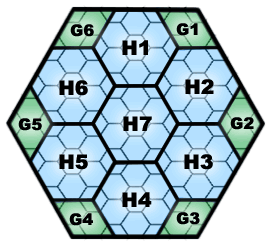Fallen empires leave many relics in their wake. One of more ubiquitous heirlooms of the Dekàli Empire is its systems of measure, which in turn were inherited largely from the people of Anū Gyð. While many cartographers and geomancers of this early time were intrigued by squares, circles, and triangles, the Anū Gyð found particular resonance with the perfection of the hexagon; which was presented to its priests by Kugùntor the White.
Dekàlan Measures
Linear
Each step in the hex-grid mapping process involves clustering seven hexes to create a hex of the next larger size. Using this method, seven Dekàlan foot hexes (3 across) form one Dekàlan yard hex, etc. The size of any given hex is determined using a diagonal measure.
Dekàlan Steps of Measurement
The following list includes the Dekàlan name and abbreviation followed by the English measurement and metric equivalent.
- Dekàlan Foot (df.) = 1.667 feet
- Dekàlan Yard/Stride (dy./dd.) = 5 feet; 1.667 yards; 1.524 meters
- Dekàlan Walk (dw.) = 15 feet; 5 yards; 4.572 meters
- 45 feet
- 135 feet
- Dekàlan Run (dn.) = 405 feet; 135 yards; 123.444 meters
- 1215 feet
- Dekàlan Mile (dm.) = 3645 feet; 0.690 miles; 1.111 kilometers
- Dekàlan League (dl.) = 10935 feet; 2.071 miles; 3.333 kilometers
- Dekàlan Ride (dr.) = 32805 feet; 6.213 miles; 9.999 kilometers
- Dekàlan Sail (ds.) = 98415 feet; 18.639 miles; 29.997 kilometers
- Dekàlan Voyage (dv.) = 295245 feet; 55.918 miles; 89.991 kilometers
Measurement Conversions
- 3 df. (Feet) = 1 dd. (Stride)
- 3 dd. (Strides) = 1 dw. (Walk)
- 27 dw. (Walks) = 1 dn. (Run)
- 9 dn. (Runs) = 1 dm. (Mile)
- 3 dm. (Miles) = 1 dl. (League)
- 3 dl. (Leagues) = 1 dr. (Ride)
- 3 dr. (Rides)= 1 ds. (Sail)
- 3 ds. (Sails) = 1 dv. (Voyage)
Cartographic Hexes
- Fractions. All named measurements can be divided into ten sub-measures, called ‘fractions’. There is no Dekàlan equivalent for the inch, or units smaller than the foot. Such details are simply noted as fractions of a foot. Example: One 1.15 feet is noted as 1 df. 1,5.
- Gores. Spaces within a given region that do not fall within the seven interior hexes are called gores. There are six gores per hex, labeled G1 through G6. Three gores equal one hex of the current step. Each gore also contains three hexes of one hex step below. Gores are only an issue cartographically speaking. Surveyed lands are in no way constrained by the arbitrary placement of hex-lines. Figure 1 displays three layers of hex steps, though only the middle step is labeled. Why bother? This system can be useful for pinpointing a location within a map (i.e. the house is located at VIII-H6, VII-H1, VI-H3, V-G1). Given this longhand, the map reader now knows specifically where the house is within a roughly 270′ area of a one mile hex. It is customary that whenever a location appears within a gore, the notation ends. Most notations are not this specific however, as maps typically do not display more than three hex steps at once.
- Notation. A standard measure 5 ft. 8 in. character is 5.666 feet tall. Converted to Dekàlan measure, this becomes 3.4 feet, or more properly 3 df. 4. One-half of a voyage might be noted as 1 ds. 5.
Volume
Weight and Mass
Date and Time
Cooking
Falling
The distance a person falls per second:
- (10m/s + 0 m/s) /2 = 5 m/s = 15 feet (total = 15 feet)
- (40 m/s + 10 m/s) /2 = 25 m/s = 75 feet (total = 90 feet)
- (90 m/s +40 m/s) /2 = 65 m/s = 195 feet (total = 285 feet)
- (160 m/s + 90 m/s) /2= 125 m/s = 375 feet (total = 660 feet)
